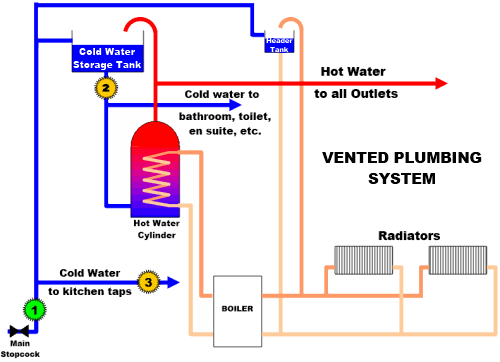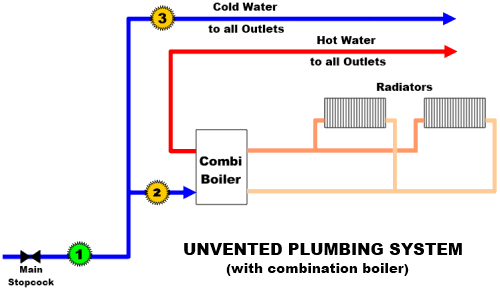Where to Locate a Water Descaler
The best place to position your descaler is where the mains water pipe enters the house, just after the main stopcock. This ensures maximum coverage and applies to all types of plumbing system. Every effort should be made to position the descaler at this optimum position (position 1 in the diagrams below). However, in the very few cases where this is not possible, the diagrams below indicate alternate locations. Firstly, determine the type of plumbing system:-
Conventional (Vented) System: These systems have a cold-water storage tank in the loft space, which in most cases also supplies all the cold-water outlets apart from the kitchen sink. The cold-water storage tank is quite a large tank and should not be confused with the smaller header tank for the central heating system.
For vented systems, the second best location for the water descaler is at the outlet from the cold-water storage tank. In some cases however, there may be multiple outlets from the storage tank, in which case the descaler should be fitted to the mains water pipe supplying the tank. Although water that has been conditioned with the descaler loses its anti-scaling properties after a while, the tank is normally replenished frequently enough to overcome this. The main disadvantage of locating the descaler at position number 2 is that the cold-water supply to the kitchen is omitted. Whilst this may only affect the kitchen sink supply, many washing machines and dishwashers are also supplied from the cold-water pipe in the kitchen and so they too would remain unprotected.
In the very unlikely event that the descaler cannot be fitted at either position 1 or position 2 as indicated in the diagram below, locating the descaler at position 3 would provide coverage to any appliances fitted to the mains water supply in the kitchen, but leave the remainder of the house unprotected.

Figure 1: Conventional (vented) Plumbing System.
Unvented Plumbing System: If you do not have a cold-water storage tank in the loft, but do have a hot-water cylinder in the airing cupboard, the likelihood is that you have an unvented system similar to that show in figure 2 below. These systems have a small, sealed, expansion vessel that replaces the vent in conventional systems. The advantages of unvented systems is that they remove the need for water storage in the roof space and that both hot and cold water outlets are at the same pressure.
As with other types of plumbing system, the ideal position to fit a descaler in an unvented system is just after the main stopcock where pipe enters the house. This is shown as position 1 in figure 2.
If the descaler cannot be fitted at position 1, then anywhere along the mains water pipe before it branches off to the various household outlets and appliances would suffice. However, locating a descaler after a branch in the pipework will mean that water from the branch remains untreated.
Position 3 in figure 2 shows a position that some people may consider as a suitable position to locate a water descaler to protect the boiler. While this is true in part, the boiler shown in figure 2 forms part of a sealed system in which the water is rarely replaced. Hence, once the limescale precipitates out of the water when the system is initially filled, no more limescale will form unless the water is replaced. This is also true of all central heating systems. And while sludge a limescale does form in these sealed systems, the limescale is minimal and would not be reduced by a water descaler.

Figure 2: Unvented Plumbing System.
Combination Boiler: If you do not have a cold-water storage tank in the loft, and if there is no hot-water cylinder in the airing cupboard, it is highly likely you have a combination-boiler. Combi-boilers provide hot water on demand and are now the most popular type of domestic plumbing installation in the UK.
As with the other plumbing systems above, position 1 in the combi-boiler diagram shown below is the best position. If this is not possible, a descaler fitted at position 2 on the inlet to the boiler would protect the hot water system and most expensive parts of the system. A third option would be to locate the descaler at position 3 shown in figure 3. This would prevent scale build-up in dishwashers, washing machines, and other appliances connected to the mains pipe after the descaler. However, a better solution would be two descaler; one fitted at position 2 and the other at position 3.

Figure 3: Unvented System with Combination Boiler.
Central Heating: In all cases, it is not necessary to fit a descaler to the central heating system. Central heating systems are sealed and the water in them is seldom replaced. Once the limescale precipitates out of the initial batch of water used to fill the system, no more will form unless the water is replaced.